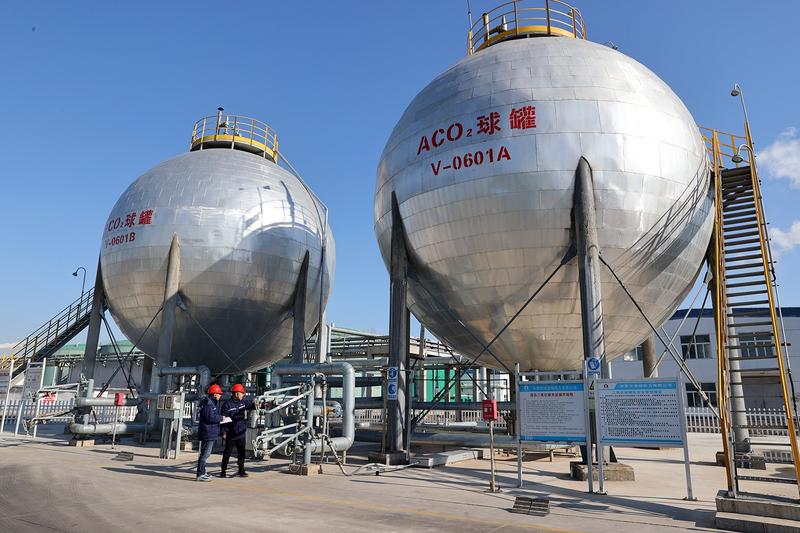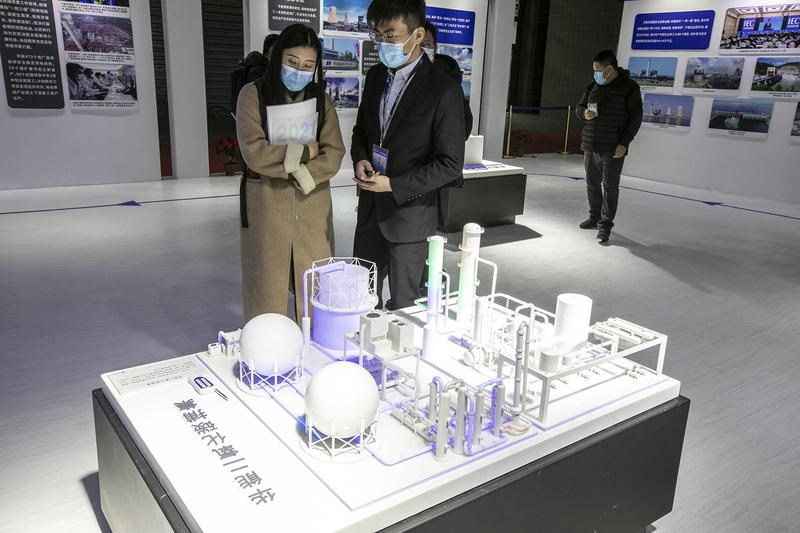Top 3 oil giants tap carbon high-tech for less emissions, larger output
 Technicians inspect a CO2 storage facility in Dongying, Shandong province, in December. (ZHOU GUANGXUE / FOR CHINA DAILY)
Technicians inspect a CO2 storage facility in Dongying, Shandong province, in December. (ZHOU GUANGXUE / FOR CHINA DAILY)
China's ambitious goal of reaching carbon neutrality by 2060 means the country is set to achieve net-zero emissions in less than 40 years.
In addition to shifting toward cleaner energy sources, including solar and wind power, China has also been working on carbon capture, which makes the technology of carbon capture, utilization and storage (CCUS) an essential part of the nation's green solutions.
Energy players at home and abroad have been expanding their presence to tap the potential of the CCUS sector-a set of methods and technologies for removing carbon dioxide from flue gas and the atmosphere, recycling it for use, and establishing safe and long-term storage modalities.
China's three biggest oil companies-China National Petroleum Corp, China Petrochemical Corp and China National Offshore Oil Corp-have all been actively laying out plans to develop CCUS, which will not only further facilitate the country's goal to achieve carbon peak and carbon neutrality, but also help boost their domestic oil output.
CNOOC recently announced it will cooperate with Shell plc and ExxonMobil to develop a carbon capture and storage (CCS) hub in Huizhou, Guangdong province. This will be China's first offshore large-scale CCS hub capable of capturing up to 10 million metric tons of carbon dioxide per year. It will significantly help reduce CO2 emissions from the area and serve the decarbonization needs of nearby enterprises, it said.
In addition to CNOOC, China Petroleum and Chemical Corp, or Sinopec, the world's largest refiner by volume, has also been stepping up large-scale development of CCUS.
The company initiated China's first megaton CCUS project last year-Sinopec Qilu-Shengli oilfield CCUS-which is expected to become China's largest whole industrial chain CCUS demonstration base and application case for promoting large-scale development of CCUS in the country.
Expected to be put into operation this year, the scheme involves sending CO2 captured at a petrochemical refinery to the Shengli oilfield, where it will be reinjected as part of the field's enhanced oil recovery program.
When completed by the end of this year, the project in East China's Shandong province will be able to cut CO2 emissions by 1 million tons per annum, it said.
Sinopec President Ma Yongsheng said developing CCUS technology represents an irresistible trend in the battle to reduce emissions, and for oil companies, reinjecting carbon dioxide from petrochemical refineries into oil wells to enhance oil recovery is also a promising way to convert trash into treasure.
 Visitors check out a model of a carbon capture and storage (CCS) facility of China Huaneng Group, a major State-owned power generator, in Shanghai in December 2020. (PHOTO PROVIDED TO CHINA DAILY)
Visitors check out a model of a carbon capture and storage (CCS) facility of China Huaneng Group, a major State-owned power generator, in Shanghai in December 2020. (PHOTO PROVIDED TO CHINA DAILY)
According to a report released by Reportlinker.com called "Carbon Capture, Utilization And Storage Global Market Report 2022" in June, the global CCUS market is expected to grow from $1.62 billion in 2021 to $1.91 billion in 2022 at a compound annual growth rate of 17.6 percent.
With an increasing number of major companies and governments investing in CCUS to reduce carbon emissions, the global market is expected to grow to $3.62 billion in 2026 at a compound annual growth rate of 17.4 percent, it said.
Sinopec plans to develop capacity to produce blue hydrogen from natural gas, combined with CCUS, as well as green hydrogen, in collaboration with China's renewable energy developers.
Blue hydrogen has its carbon emissions captured and stored, or reused, while green hydrogen is generated by renewable energy sources without producing carbon emissions.
CNPC, the country's largest oil and gas producer as well as supplier, has also been working on capturing CO2 from industrial sources such as plants producing gas-fired power, petrochemicals, coal-based chemicals or iron and steel.
The company has built a plant in Jilin province, with capacity to separate and capture 200,000 tons per annum of CO2.
One of the reasons for the extensive layout of the country's carbon storage sector is that China has significant geological potential for storing carbon-an estimated 2,400 gigatons in storage capacity-second only to the United States, said a report by Shell plc.
China currently has more than 40 CCUS pilot projects with a total capacity of 3 million tons. Many of these projects are small developments linked to enhanced oil recovery. This will need to scale up significantly over the next four decades, it said.
In a net-zero emissions energy system, a little more than 1.3 Gt of carbon dioxide a year will need to be captured and permanently stored by 2060. This means CCUS capacity will need to increase more than 400-fold in the next four decades, said Shell plc in the report.
While this is technically possible as lots of CCUS technologies in China are close to or have reached commercialization, the main challenge lies in creating conditions to support substantial investment in large-scale CCUS, particularly as a solution to industrial decarbonization, it said.
Luo Zuoxian, head of intelligence and research at the Sinopec Economics and Development Research Institute, said the increase in focus on reducing CO2 emissions is driving the CCUS market.
"CCUS offers a way to reduce emissions from sectors that are hard to decarbonize, including iron and steel, chemicals and petrochemicals, and the key to tackling the problem lies in the technological breakthroughs of CCS and CCUS," Luo said.
"Countries across the globe are committed to becoming carbon neutral by as early as 2050 while oil firms, including Shell and Total, have pledged to invest hundreds of millions of US dollars in carbon dioxide storage projects to decrease CO2 emissions."
Luo added that using captured CO2 to enhance oil recovery or to create synthetic fuels and chemicals can play an important role in the transition to net zero, which may also help displace fossil fuels in the short term and provide an additional revenue stream to support the commercialization of carbon capture.
However, Luo said high costs and technologies have long been a hurdle for further expansion of CCUS projects at home and abroad.
"The high cost and relatively less mature technology still hold many projects from being put into operation. For example, major energy players have been working on the offshore carbon storage project for years, but we are still in the middle of exploring and experimenting with no solid project having been put into operation so far due to prohibitive costs," he said.
According to the Shell report, public policy action is also needed now to achieve this scale of CCUS by 2060. Action includes a robust and rising carbon pricing mechanism to make CCUS commercially viable in the long term, it said.
In addition, rewarding CCUS emission reductions will drive greater investment in the technology, and policy action will need to include support for commercializing capture technology for direct air capture and for various end uses in the short term, particularly in power generation and industry.
Policy frameworks that reduce investment risks and capital costs will attract private capital in the near-term. Other measures, such as clarifying long-term liability requirements for permanent carbon storage, will facilitate greater market adoption, it said.


